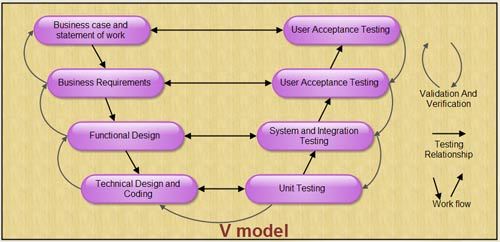The V model is useful in every phase of the software development life cycle. This model determines the complex relationship between each phase of the software development and ensures that each phase of software development is associated with testing. Various functions performed by V model are listed below.
- It emphasizes that testing occurs in every phase of software development and does not occur only after the coding is completed.
- It determines the software development process within the organization.
- It determines the activities and the results to be produced in the software development.
- It describes the products to be created during the software project.
The V model is divided into two branches: left and right. The left branch analyzes and determines the requirements of the software to be developed. The right branch, on the other hand, includes the testing activities. The left and right branches of this model work concurrently. This implies that a relationship is established between both the branches.
The interrelationship between the branches of V model can be determined by the following points.
- Unit testing verifies the technical design. It individually tests units to verify that they (units) are functioning according to the requirements.
- The integration and system testing verifies the functional design of the program, to ensure that the functional design is implemented correctly.

- The requirements of the business are validated at the user end with the help of acceptance testing. Acceptance testing is used when the final software is developed. It verifies that the software has been developed according to the user’s requirements.
- Last of all, the production verification is carried out.
One of the key aspects of the V model is that verification and validation are performed simultaneously in both the branches. It is essential to link the left branch with the right branch as the left side of V model is executed to correct problems, which are encountered during verification and validation (the right side).
Various advantages and disadvantages associated with the V model are listed in Table
Table Advantages and Disadvantages of V Model
Advantages | Disadvantages |
|
|
 Dinesh Thakur holds an B.C.A, MCDBA, MCSD certifications. Dinesh authors the hugely popular
Dinesh Thakur holds an B.C.A, MCDBA, MCSD certifications. Dinesh authors the hugely popular